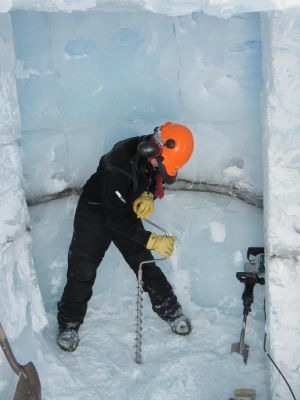 By Nicole Geary
By Nicole Geary
Last year, Lindsay (Martin) Knippenberg tunneled into the base of a 50-foot-deep glacier to challenge the limits for life on Earth.
Meanwhile, she encouraged more than a few young people to broaden their perspectives about science – and consider new possibilities for their future.
Hundreds of U.S. students and fellow teachers, back in the comfort of their classrooms, followed Knippenberg as she spent two frozen, thrilling months on a research expedition studying microorganisms in Antarctica.
The journey was part of PolarTREC, a National Science Foundation-funded program that allows K-12 teachers to conduct cutting-edge polar research and share their experiences through blogs, discussion boards and Webinars.
Only 15 teachers were selected for the 2009-10 school year from more than 250 applicants across the nation.
“I try to do things with my students to show them that you can go outside your comfort zone and achieve great things,” said Knippenberg, a high school biology teacher in St. Clair Shores, Mich. “Most of them thought I was crazy, but it was inspiring to see them get excited about science in ways they wouldn’t have before.”
Polar science, after all, isn’t covered by state objectives and benchmarks for science content. And it’s not every day that the average high school teacher endures -40-degree temps in the name of learning.
But Knippenberg, who graduated from MSU’s secondary education program in 2002, doesn’t shy away from unique opportunities to enrich her teaching in the field.
She went on research trips to study seals in Alaska and wolves in Michigan’s Upper Peninsula as an undergraduate at MSU. Then she hiked through the mucky wetlands of an Ohio wildlife refuge while working on her master’s degree in environmental science from University of Michigan-Dearborn.
At South Lake High School, where she’s been teaching for seven years, Knippenberg organizes a host of community-based projects for students as coordinator of the Environmental Club. Principal Lou Steigerwald wasn’t surprised to see her pursue PolarTREC.
“It’s the sort of thing that Lindsay does to extend her knowledge – go and find new things to know about and bring them to her classes,” he said.
An extreme learning experience
From her tent in the McMurdo Dry Valleys of Antarctica, Knippenberg huddled over a laptop and documented her daily activities via satellite. She posted pictures, described ongoing field work, mapped out lesson ideas for teachers and carried on conversations with students all through her own section of the PolarTREC Web site.
 When the Grosse Ile, Mich. native wasn’t translating complex biogeochemical concepts into language for a general audience, she was doing everything the researchers did: cutting ice blocks by chainsaw, drawing samples of glacial sediment and (later) running tests in the laboratory.
When the Grosse Ile, Mich. native wasn’t translating complex biogeochemical concepts into language for a general audience, she was doing everything the researchers did: cutting ice blocks by chainsaw, drawing samples of glacial sediment and (later) running tests in the laboratory.
The six-person team from Montana State University and Louisiana State University was looking for proof that microorganisms can live trapped inside Antarctic debris-rich glacier ice – a question with implications for the extreme conditions of icy moons and planets elsewhere in our solar system. The researchers found strong preliminary evidence but need more analysis.
“We teach about the scientific method, but to watch me go through it helps students understand how it actually works,” said Knippenberg, who made an introductory trip to lead principal investigator Mark Skidmore’s Montana State lab last summer and hopes to continue collaborating with the team.
The “elegantly simple” class experiments and other strategies Knippenberg devised to synthesize science concepts while in Antarctica have already inspired Skidmore, a geomicrobiologist, to share his research in local schools.
“Most scientists are adept at their work, but relating it to middle or high school kids, that’s not where our skill set lies,” he said. “If I wasn’t excited about science by my teachers, I don’t think I would have gone on to be a scientist.
“It’s important to train the next generation.”
Making it real, memorable
Always enthusiastic about science, Knippenberg says she nearly traded teaching for a career in research herself. The chance to influence kids – and Michigan State’s full-year teaching internship – won her over.
“Thinking back, I remember how easy my first year of teaching was and how prepared I felt,” she said. “It was almost like I was starting my second year of teaching, not my first… Now I’ve been doing it for seven years and I can’t imagine anything different.”
Leaving her classroom for Antarctica (NSF paid for the substitute teacher), she was free to follow in the climbing shoe prints of top-notch researchers and revel in the splendor of bright blue ice under 24-hour sun.
Still, she became most immersed in making the dreamlike world real for students.
Blogging, about where bacteria could grow and what it takes to run a polar research station for example, was her favorite part. When she hosted a live remote Webinar about the research project, about 30 schools, a museum and even a zoo logged on to listen.
“It was amazing knowing that I was in Antarctica and they were all over the country, talking to one another,” she said, realizing her own students, and almost all of South Lake High School, had tuned in too.
Back in the classroom, she plans to incorporate her new firsthand knowledge into existing part of the curriculum and build more lessons beyond today’s dated textbook pages.
Ultimately, Knippenberg – a teacher who has been to the bottom of the earth – hopes to hear more students say they are headed toward their heights with careers in science, engineering and more.
“One of the things I remember most from my science teaching classes is the importance of making education memorable,” she said. “I hope that I am influencing them.”




